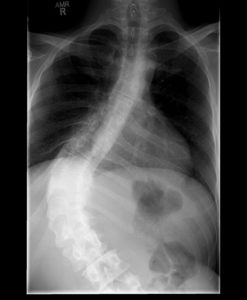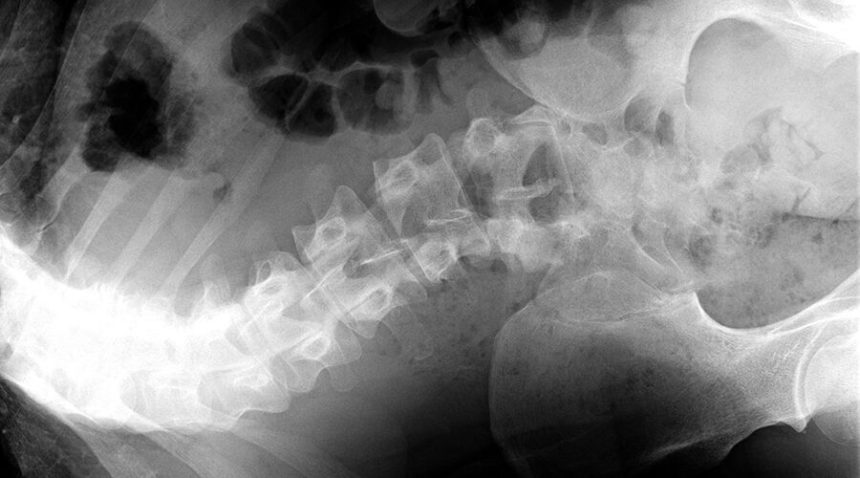Matthew Doyle, of Caswell County in north central North Carolina, looks like he’s in a band or fresh from a skate park in his skinny jeans and cap.
You’d never know it, but a couple of years ago, Doyle had scoliosis correction surgery with screws and rods to treat a severe curve in his spine.
He wasn’t even aware of this curve until one day in 2012 when he was hanging out with his uncle and brother. He had lost weight, and his spine’s shape had become more visible. “I was wearing a shirt that was just a little bit tight around my torso, and my uncle and brother noticed my spine was crooked.”
That’s when Doyle looked in the mirror and saw it himself.

After an X-ray at a local hospital, Doyle was shown two images so he could compare his spine to one without scoliosis. His lower spine was clearly different: His curved to the right.
Doyle didn’t receive immediate treatment. For years, the difficulty of finding a clinic that could offer financial assistance combined with his need to focus on his studies and work prevented him from finding treatment he could afford.
“In 2015, I finally went to a local doctor that referred me to UNC. Their charity care assistance program ended up taking care of a lot of my bills,” Doyle says.
He made an appointment with Deb Bhowmick, MD, a neurosurgeon at UNC Medical Center.
Scoliosis Consultation
“Matthew was having trouble with endurance,” Dr. Bhowmick says. “He was having a significant amount of pain with prolonged upright posture, including standing and walking.”
Dr. Bhowmick started Doyle with exercises to see if the scoliosis could be improved noninvasively. “I was asked to come back in a year to see if the exercises alone would correct my spine,” Doyle says. Ultimately, Dr. Bhowmick recommended surgery.
Scoliosis correction surgery involves cutting out wedges in the vertebrae to create more mobility, adjusting the spine into a straighter position and then using screws and rods to fix the spine into that straighter position.
“For adults, when the curve in the spine is more than 40 degrees, it’s likely that it will get worse, but surgery is not recommended unless they have one of two problems,” Dr. Bhowmick says. “One is a nerve or spinal cord impingement causing pain or disability, and the other reason is rapid progression of their curve causing deformity and pain with upright posture.”
In Doyle’s case, the scoliosis continued to get worse, and it was causing deformity and pain with upright posture. Eventually, the curve in his lower spine worsened to about 80 degrees.
“That’s when I decided I wanted the surgery,” Doyle says.
Scoliosis Surgery

The night before his surgery in September 2016, Doyle went for a jog, knowing that the procedure would limit his mobility for several months.
His memories of the moments before the surgery are hazy—“I don’t even remember the whole count-backwards thing.” But he does remember how he felt when he got another X-ray right after the surgery.
Doyle and Dr. Bhowmick could see a huge difference immediately.
“He was impressed with the cosmetic results. He no longer leaned off to one side. Certainly he was very happy about that,” Dr. Bhowmick says.
But Doyle was in for a challenging recovery period.
“We ask patients to not do any bending, lifting more than 10 pounds or twisting for about three months after the surgery. And we restrict them from high-impact activities after three months,” Dr. Bhowmick says.
It takes between six months and two years for the bones to heal together. That’s why patients keep coming back for X-rays, to check the progress.
Doyle longed to return to exercise but had to take it easy. After the first month of keeping pretty still, he slowly started incorporating safe exercises into his life. “I definitely was careful with how I did what I did,” he says.
Now, two years later, Doyle says he’s basically able to exercise like he did before surgery, and his spine is almost perfectly straight.
“It not only changed my physical appearance, it changed how I live my life,” Doyle says. “For people that have scoliosis, whether it’s mild or like what I had, don’t think that you don’t have any options.”
Struggling with neck or back pain? Find a doctor near you who can help.

